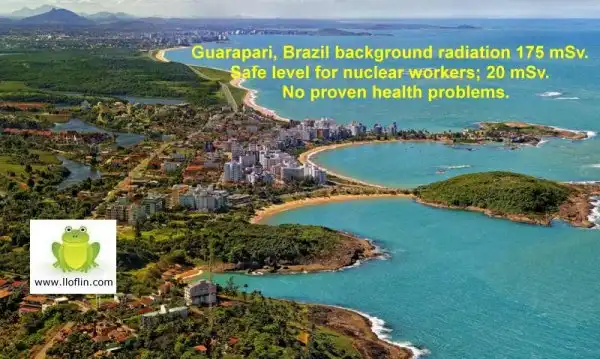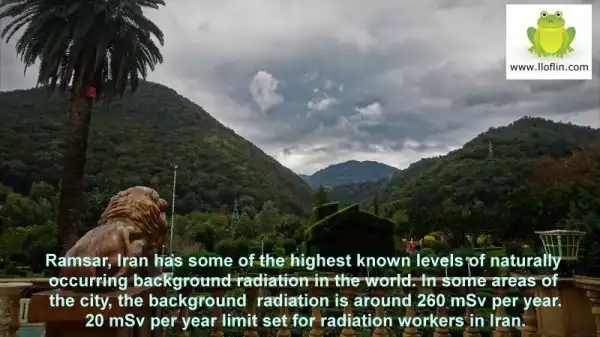Introduction
Low-level radiation is often blamed for increased cancer rates, but data suggests humans are more resilient than claimed. Areas like Nevada, near the Nuclear Test Site, and naturally radioactive places like Ramsar, Iran, show no significant health impacts despite high radiation exposure. Confounding factors—smoking, mining conditions, diesel exhaust—complicate cancer studies, often leading to overstated risks. This page uses empirical evidence to explore how humans handle low-level radiation, from fallout zones to tourist destinations with natural radioactivity, challenging alarmist narratives and highlighting the need for reason and data in understanding radiation’s effects on human health.
Key Terms
Low-Level Radiation: Radiation doses below 100 mSv/year, often from natural or artificial sources (Lance, 2018).
mSv (Millisievert): Unit measuring radiation dose; 20 mSv/year is the limit for radiation workers in Iran (Lance, 2018).
Linear No-Threshold Model: Theory that any radiation dose increases cancer risk, even at low levels (Lance, 2018).
Low-Level Radiation and Cancer: Nevada and Utah
The Nevada Nuclear Test Site, 65 miles northwest of Las Vegas, hosted 928 nuclear detonations from 1951 to 1992, with fallout affecting Nevada and Utah. If low-level radiation significantly increased cancer, these states should show elevated rates. CDC data from 2020 tells a different story: Nevada’s cancer death rate was 144 per 100,000, lower than Iowa (149), Delaware (155), and Oregon (152), and similar to Rhode Island (145). Utah had one of the lowest rates nationally at 129 per 100,000 (CDC, 2020). From 2005 to 2020, Nevada’s rate dropped from 191 to 144, while Utah’s remained stable. Kentucky, with no fallout, had the highest rate at 177.3 in 2020, suggesting other factors drive cancer more than radiation.
Confounding Factors in Cancer Studies
Studies linking radiation to cancer often overlook confounding factors. Uranium miners, frequently cited as proof of radiation’s harm, face elevated health risks from their occupation. Hard rock mining exposes workers to toxic dust, which can cause lung issues like cancer or black lung, as seen in coal miners (Fisher, 2012). Many miners are heavy smokers—28.1% in a New Jersey study, compared to 41.7% using tobacco overall (Fisher, 2012). Diesel exhaust, wood stove smoke, and genetics also contribute to lung cancer risk. A 2012 study found non-smokers with high diesel exposure were seven times more likely to die from lung cancer than those with low exposure, while heavy smokers showed less risk, possibly due to lung clearance mechanisms (Fisher, 2012). These factors complicate attributing cancer solely to radiation.
Naturally Radioactive Places: Ramsar and Guarapari
Humans thrive in naturally radioactive areas, challenging the linear no-threshold model. Ramsar, Iran, on the Caspian Sea, has background radiation levels up to 260 mSv/year—far above the 20 mSv/year limit for radiation workers in Iran. Yet, studies show fewer chromosomal abnormalities and lower lung cancer rates in high-radiation areas of Ramsar compared to low-radiation zones with more radon (Lance, 2018). Life expectancy in Ramsar matches neighboring areas with less radiation. Guarapari, Brazil, a coastal tourist destination, is famous for its radioactive beaches due to thorium in the sand. Despite elevated radiation, no adverse health effects are reported, and the area remains a popular spot for visitors seeking its natural beauty (Lance, 2018).


Visiting Radioactive Sites
Radioactive sites, both artificial and natural, are safe for visitors when managed properly. The Nevada Nuclear Test Site offers public tours, including the 1,280-foot-wide, 320-foot-deep Sedan Crater, resuming in 2022 after a COVID hiatus (NNSS, 2022). Bikini Atoll provides diving tours to explore shipwrecks from nuclear tests, and Chernobyl welcomed over 70,000 tourists in 2018, showcasing its wildlife (The Conversation, 2019). Naturally radioactive destinations like Ramsar and Guarapari attract visitors without health concerns. These sites demonstrate that low-level radiation poses minimal risk to humans, allowing safe exploration of areas once thought hazardous, as long as basic precautions—like not ingesting contaminated soil—are followed.
Conclusion
Data from Nevada, Utah, Ramsar, and Guarapari shows humans are not highly sensitive to low-level radiation. Nevada’s cancer rate dropped to 144 per 100,000 by 2020 despite nuclear fallout, and Ramsar residents have lower lung cancer rates despite 260 mSv/year radiation. Confounding factors like smoking and diesel exhaust better explain cancer risks in mining studies. Radioactive sites like the Nevada Test Site and Guarapari are safe to visit, proving radiation fears are often overstated. By focusing on empirical evidence, we can address real health risks—smoking, pollution—while appreciating nature’s resilience and living safely with low-level radiation.
References
- CDC. (2020). Cancer Death Rates by State.
- Fisher, V. A. (2012). Diesel Exhaust Exposure in Miners Linked to Lung Cancer. MPH Study.
- Lance, S. (2018). Ramsar and Radioactivity.
- NNSS. (2022). Nevada Test Site Tours. https://www.nnss.gov/docs/fact_sheets/DOENV_1033.pdf.
- The Conversation. (2019). Chernobyl as a refuge for wildlife. https://theconversation.com/chernobyl-has-become-a-refuge-for-wildlife-33-years-after-the-nuclear-accident-116303.
- Bristol Blog. (n.d.). Radiation Basics. https://www.bristolblog.com/news1/news8.htm.
Evidence based Earth Science
- Climate Change is not a Hoax - Bristol Blog
- Plant Stomata CO2 Climate Record - Bristol Blog
- Oceans Regulate Climate: Earth’s Resilience
- Answering the Eco-Luddites Fear of Technology
- Eco-Theology: Indoctrinating Kids, Breaking the Constitution
- Environmentalism as Religion: Dogma Over Data
- Lovelock, Earth vs. Venus, and Hansen’s Alarmism
- Venus Was Never Like Earth: Science Demands Proof
- Arctic Ice Defies Climate Models: A Case for Natural Cycles
- Nuclear power and radiation facts:
- Applied Science in Action: Nuclear Reactors and Radiation Realities in Southwest Virginia
- Solar, Wind are Climate Corporatism - Bristol Blog
- CANDU Reactors – A Clean Nuclear Solution
- Standardizing Nuclear Reactors and Cutting Politics
- Nuclear Graveyards Abound with Life
- What About Humans and Nuclear Radiation?
- Radiation Basics They Should Teach in High School
- Misconceptions About Radon: Data Over Fear in Public Policy
- Natural Radioactivity in Everyday Life: Separating Fact from Fear
- What Level of Knowledge Do You Need for Electronics Technology?
- Electronics and Technology for the Hobbyist and Home Scientist
